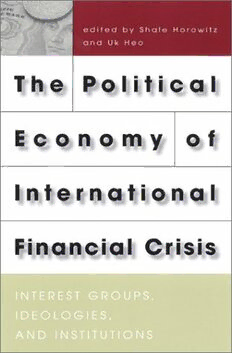
The Political Economy of International Financial Crisis: Interest Groups, Ideologies, and Institutions. PDF
305 Pages·2001·10.36 MB·English
Most books are stored in the elastic cloud where traffic is expensive. For this reason, we have a limit on daily download.
Preview The Political Economy of International Financial Crisis: Interest Groups, Ideologies, and Institutions.
Description:
The world financial crisis of 1997-99 was the most important international economic event since the oil shocks of the 1970s and the associated debt crisis of the 1980s. What were its political causes and consequences? In particular, how did interest group coalitions and political institutions affect pre-crisis economic policies and post-crisis responses? This book focuses on how policymaking coalitions are formed and how political institutions mediate the pressure of rival coalitions. This approach is applied to 13 countries drawn from the main crisis-affected regions of the world economy--East Asia, Southeast Asia, Latin America and Eastern Europe.
See more
The list of books you might like
Most books are stored in the elastic cloud where traffic is expensive. For this reason, we have a limit on daily download.
